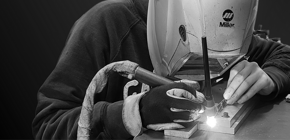In the maritime industry, quality welding is crucial for ensuring the structural integrity and safety of naval vessels. The Naval Sea Systems Command (NAVSEA) plays a vital role in maintaining and modernizing these vessels. Selecting a NAVSEA welder is a meticulous process that requires careful consideration to ensure that the highest standards of welding are met. This blog post will walk you through the key steps in selecting a NAVSEA welder.
Step 1: Understanding NAVSEA Standards and Requirements
NAVSEA has established rigorous welding standards and specifications to guarantee the quality and reliability of welds on naval vessels. Before embarking on the selection process, it's important to familiarize yourself with NAVSEA's welding requirements. These standards encompass welding techniques, materials, testing methods, and certifications. The NAVSEA Technical Publication S9074-AQ-GIB-010/248 provides comprehensive guidelines for welding processes, ensuring that welders meet the stringent criteria.
Step 2: Identifying Qualifications and Certifications
When selecting a NAVSEA welder, certifications and qualifications are paramount. Look for welders who hold relevant certifications such as NAVSEA Welding Procedure Specifications (WPS) and American Welding Society (AWS) certifications. The welder should be proficient in various welding processes, including Shielded Metal Arc Welding (SMAW), Gas Metal Arc Welding (GMAW), Flux-Cored Arc Welding (FCAW), and Gas Tungsten Arc Welding (GTAW). These certifications ensure that the welder possesses the necessary skills to execute high-quality welds following NAVSEA standards.
Step 3: Evaluating Experience and Expertise
Experience is a crucial factor when selecting a NAVSEA welder. Consider welders with a proven track record of working on naval vessels or similar projects. An experienced welder understands the nuances of maritime welding, including the challenges posed by the marine environment, differing material properties, and vessel-specific requirements. A well-established portfolio of successful welding projects demonstrates the welder's capability to deliver reliable and structurally sound welds.
Step 4: Reviewing Welding Equipment and Facilities
To meet NAVSEA standards, the welder's equipment and facilities must align with the required specifications. Verify that the welder utilizes modern and well-maintained welding equipment, including welding machines, electrodes, filler materials, and protective gear. Additionally, assess the welder's workspace's cleanliness and organization to ensure a safe and efficient working environment is maintained.
Step 5: Conducting Quality Control and Testing
Quality control and testing are pivotal in the selection process. NAVSEA welders should be well-versed in non-destructive testing (NDT) techniques, such as radiographic testing (RT), ultrasonic testing (UT), and magnetic particle testing (MT). These methods are employed to detect defects and irregularities in welded joints, ensuring the integrity of the welds. Request information on the welder's quality assurance processes and their ability to adhere to NAVSEA's stringent testing requirements.
Selecting a NAVSEA welder involves a meticulous process aimed at upholding the highest standards of welding in the maritime industry. By understanding NAVSEA's welding requirements, evaluating qualifications and certifications, considering experience and expertise, reviewing equipment and facilities, and emphasizing quality control and testing, you can confidently choose a welder who will deliver exceptional results. Prioritizing these steps ensures that naval vessels are equipped with reliable, structurally sound welds that contribute to the safety and longevity of these vital assets.

COMMENTS